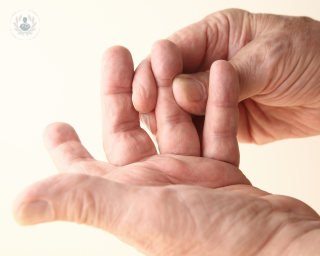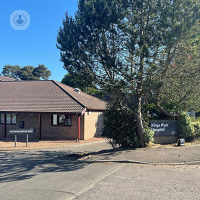What is osteoarthritis of the hand?
Hand osteoarthritis is a degenerative joint condition, resulting in join pain, stiffness, and swelling in the hand. It most commonly occurs in the wrist, fingertips (DIP joint), middle knuckle (PIP joint), and the basilar joint (which connects the thumb and wrist).
Osteoarthritis is where the cartilage that cushions the bones at the joints wears away, which causes the bones to rub against one another, leading to inflammation, stiffness and pain.

What are the symptoms of hand arthritis?
The symptoms of osteoarthritis include:
- Pain – located around a joint or part of the hand, e.g. thumb, wrist, knuckle
- Stiffness – this can make it difficult to perform tasks such as using a phone or buttoning a shirt.
- Weakness – the patient may find it difficult to grip or pinch. It may hinder tasks like opening jars or turning the key in a car’s ignition.
- Nodes – bony growths that can develop where the bones have been rubbing. Heberden’s nodes develop on the end knuckle (the DIP joint), while Bouchard’s nodes develop on the middle knuckle (PIP joint).
- Bone spur
What causes hand arthritis?
Osteoarthritis of the hand occurs due to gradual wear and tear of the joint, which results in the cartilage wearing away. The cartilage is responsible for cushioning the bones and allowing smooth movement. Without it, the bones rub together, and movement becomes stiff. The exact cause of the initial deterioration is unknown.
What are the associated risk factors of hand arthritis?
More women develop osteoarthritis than men. Patients born with defective cartilage or malformed joints are also at increased risk. Other risk factors include:
- Old age
- Hand injuries
- Jobs requiring a lot of hand work, e.g. manufacturing jobs
- A family history of osteoarthritis
What is the treatment?
Osteoarthritis is a progressive disease, meaning there is no cure, and it will continue to get worse over time. However, it can be managed and its symptoms can be treated with a number of different methods:
- Pain medication – this is directed at relieving the symptoms of pain and inflammation. Over-the-counter anti-inflammatories are usually sufficient, but in extreme cases your doctor might prescribe something stronger.
- Exercises – simple exercises, such as touching your thumb to each fingertip, making a fist and then unfurling the fingers, or walking your fingers up and down a wall can help maintain flexibility in the hands
- Hot and cold compresses
- Splints for support on the digits or wrist
- Using tools designed to help people with arthritis
- Surgery – if osteoarthritis doesn’t respond to other treatments, there are surgical options. This could mean fusing the bones on either side of the arthritic joint together, limiting movement, but also limiting pain and inflammation. The other option is to reconstruct the joint, transplanting soft tissue from other parts of the body to replace the lost cartilage.
Hand arthritis
Mr Muhammad Adeel Akhtar - Orthopaedic surgery
Created on: 11-13-2012
Updated on: 11-03-2023
Edited by: Conor Lynch
What is osteoarthritis of the hand?
Hand osteoarthritis is a degenerative joint condition, resulting in join pain, stiffness, and swelling in the hand. It most commonly occurs in the wrist, fingertips (DIP joint), middle knuckle (PIP joint), and the basilar joint (which connects the thumb and wrist).
Osteoarthritis is where the cartilage that cushions the bones at the joints wears away, which causes the bones to rub against one another, leading to inflammation, stiffness and pain.

What are the symptoms of hand arthritis?
The symptoms of osteoarthritis include:
- Pain – located around a joint or part of the hand, e.g. thumb, wrist, knuckle
- Stiffness – this can make it difficult to perform tasks such as using a phone or buttoning a shirt.
- Weakness – the patient may find it difficult to grip or pinch. It may hinder tasks like opening jars or turning the key in a car’s ignition.
- Nodes – bony growths that can develop where the bones have been rubbing. Heberden’s nodes develop on the end knuckle (the DIP joint), while Bouchard’s nodes develop on the middle knuckle (PIP joint).
- Bone spur
What causes hand arthritis?
Osteoarthritis of the hand occurs due to gradual wear and tear of the joint, which results in the cartilage wearing away. The cartilage is responsible for cushioning the bones and allowing smooth movement. Without it, the bones rub together, and movement becomes stiff. The exact cause of the initial deterioration is unknown.
What are the associated risk factors of hand arthritis?
More women develop osteoarthritis than men. Patients born with defective cartilage or malformed joints are also at increased risk. Other risk factors include:
- Old age
- Hand injuries
- Jobs requiring a lot of hand work, e.g. manufacturing jobs
- A family history of osteoarthritis
What is the treatment?
Osteoarthritis is a progressive disease, meaning there is no cure, and it will continue to get worse over time. However, it can be managed and its symptoms can be treated with a number of different methods:
- Pain medication – this is directed at relieving the symptoms of pain and inflammation. Over-the-counter anti-inflammatories are usually sufficient, but in extreme cases your doctor might prescribe something stronger.
- Exercises – simple exercises, such as touching your thumb to each fingertip, making a fist and then unfurling the fingers, or walking your fingers up and down a wall can help maintain flexibility in the hands
- Hot and cold compresses
- Splints for support on the digits or wrist
- Using tools designed to help people with arthritis
- Surgery – if osteoarthritis doesn’t respond to other treatments, there are surgical options. This could mean fusing the bones on either side of the arthritic joint together, limiting movement, but also limiting pain and inflammation. The other option is to reconstruct the joint, transplanting soft tissue from other parts of the body to replace the lost cartilage.


Thumb arthritis: are steroid injections worth it?
By Mr Andrew Logan
2024-12-14
If you're living with regular pain and discomfort from thumb arthritis, you might be wondering what all of your different treatment options are. For some people, steroid injections may be enough to ease the pain. Read more from our expert orthopaedic surgeon Mr Andrew Logan on who is best suited to injections for osteoarthritis of the thumb. See more


Surgery is not the only answer – non-surgical treatment for thumb arthritis
By Miss Tanaya Sarkhel
2024-12-14
Pain at the base of the thumbs can make simple things a real challenge. Undoing jar lids and soda bottle tops, fiddling with buttons, lifting saucepans – everyday actions that were no trouble yesterday can find us asking for help today without any rhyme or reason. What’s going on? Expert orthopaedic surgeon Miss Tanaya Sarkhel has the answers. See more


Keeping psoriatic arthritis under control
By Dr Joel David
2024-12-14
Psoriatic arthritis is a progressive and challenging form of arthritis and cause lon-lasting danage to your joints. With the development of modern medication we can now relieve symptoms and keep them under control. Rheumatologist, Dr Joel David, tells us more about this disease and how to manage to live with it. See more


Arthritis in the hands: how to alleviate pain
By Mr James Nicholl
2024-12-14
If you're living with osteoarthritis in your hands, the pain may be unbearable when it flares up. Thankfully there are ways to alleviate pain, whether at home making certain hand exercises or through medical intervention. One of our expert orthopaedic surgeons Mr James Nicholl explains more. See more
Experts in Hand arthritis
-
Mr Andrew Fitzgerald
Orthopaedic surgeryExpert in:
- Spinal surgery
- Hand surgery
- Wrist surgery
- Elbow
- Carpal tunnel surgery
- Hand arthritis
-
Mr Patrick Gillespie
Plastic surgeryExpert in:
- Warts
- Carpal tunnel syndrome
- Dupuytren’s contracture
- Skin cancer
- Cysts
- Hand arthritis
-
Mr Andrew Logan
Orthopaedic surgeryExpert in:
- Carpal tunnel syndrome
- Dupuytren’s contracture
- Wrist surgery
- Trigger finger
- Hand arthritis
- Hand surgery
-
Mr Philip Mathew
Orthopaedic surgeryExpert in:
- Wrist arthroscopy
- Carpal tunnel syndrome
- Hand arthritis
- Dupuytren’s contracture
- Wrist surgery
- Hand fracture
-
Mr Ritesh Sharma
Orthopaedic surgeryExpert in:
- Carpal tunnel syndrome
- Cubital tunnel syndrome
- Hand arthritis
- Dupuytren’s contracture
- Trigger finger
- Wrist surgery
- See all

Private Care at Chelsea and Westminster Hospital
Private Care at Chelsea and Westminster Hospital
Chelsea and Westminster Hospital, 369 Fulham Rd.
No existe teléfono en el centro.
By using the telephone number provided by TOP DOCTORS, you automatically agree to let us use your phone number for statistical and commercial purposes. For further information, read our Privacy Policy
Top Doctors

Kings Park Hospital - part of Circle Health Group
Kings Park Hospital - part of Circle Health Group
Polmaise Road Stirling FK7 9JH
No existe teléfono en el centro.
By using the telephone number provided by TOP DOCTORS, you automatically agree to let us use your phone number for statistical and commercial purposes. For further information, read our Privacy Policy
Top Doctors

Chelsea Outpatients Diagnostic Centre
Chelsea Outpatients Diagnostic Centre
Chelsea Outpatient Centre, 280 King's Rd, London SW3 5AW
No existe teléfono en el centro.
By using the telephone number provided by TOP DOCTORS, you automatically agree to let us use your phone number for statistical and commercial purposes. For further information, read our Privacy Policy
Top Doctors
-
Private Care at Chelsea and Westminster Hospital
Chelsea and Westminster Hospital, 369 Fulham Rd., Central LondonExpert in:
- General Surgery
- Dermatology
- Paediatric Dermatology
- Paediatrics
- Preventive paediatrics
- Adult and paediatric services
-
Kings Park Hospital - part of Circle Health Group
Polmaise Road Stirling FK7 9JH, StirlingExpert in:
- Vascular Surgery
- Cardiology
- Colorectal surgery
- General Surgery
- Neurological spinal surgery
- Plastic surgery, reconstructive and aesthetics
-
Chelsea Outpatients Diagnostic Centre
Chelsea Outpatient Centre, 280 King's Rd, London SW3 5AW, Central LondonExpert in:
- Physiotherapy
- General practice
- Health check up
- Emergency Service 24h
- Trauma
- See all
- Most viewed diseases, medical tests, and treatments
- Ulnar nerve entrapment
- Peripheral nerve block
- Peripheral neuropathy
- Facial feminisation surgery
- Migraine
- Paediatric rheumatology
- Autoimmune diseases
- Joint pain
- Lumbar herniated disc
- Abdominal pain








